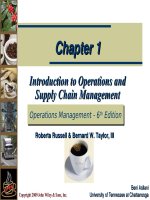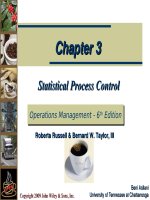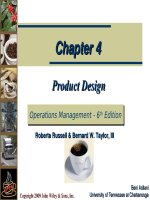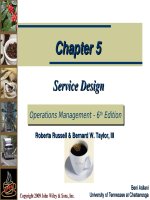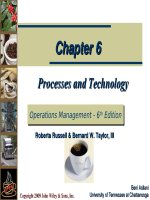Enterprise systems for management 2nd by motiwalla and thompson chapter 04
Bạn đang xem bản rút gọn của tài liệu. Xem và tải ngay bản đầy đủ của tài liệu tại đây (512.16 KB, 45 trang )
CHAPTER 3
ENTERPRISE
SYSTEMS
ARCHITECTURE
1
Copyright © 2012 Pearson Education, Inc. Publishing as Prentice Hall
Learning Objectives
•
Examine in detail the enterprise systems modules and architecture.
•
Understand the effects of a well-designed architecture on ERP
implementation.
•
Know the various types of ERP architectures and the related benefits and
drawbacks of each architecture.
•
Learn about the Service Oriented Architecture and its impact on ERP
systems.
•
Learn about cloud architecture and its impact on ERP systems.
2
Copyright © 2012 Pearson Education, Inc. Publishing as Prentice Hall
Preview
•
Once ERP systems are integrated and implemented successfully in a
company, they become the cornerstone of the organization because every
single transaction will be processed through this system.
•
In addition to the Systems Integration, it is also necessary to focus on:
–
–
–
–
–
–
Business process architecture.
Business requirements.
Budget.
Project management.
Commitments from top management.
Continuous communication with employees informing them
about future changes.
3
Copyright © 2012 Pearson Education, Inc. Publishing as Prentice Hall
Why Study Enterprise Systems Architecture?
•
Help management and the implementation teams understand in detail the
features and components of the enterprise system.
•
Provide a visual representation of the complex system interfaces among
the ERP application and databases, operating systems, legacy
applications, and networking.
•
Management can develop a better IT plan if the requirements for system
infrastructure, training, change management, and business process
reengineering are clarified.
4
Copyright © 2012 Pearson Education, Inc. Publishing as Prentice Hall
Components of the Enterprise Systems Architecture
•
Functional
– Defines the ERP modules that support the various business
functions of the organization. Examples include:
•
•
•
•
•
•
Accounting
Human Resources
Procurement
Fulfillment
Etc.
System
– Defines the ERP architecture through the physical components
of hardware, software, and networking angle.
5
Copyright © 2012 Pearson Education, Inc. Publishing as Prentice Hall
Figure 3-1 Enterprise Systems Architecture (ESA)
Model
6
Copyright © 2012 Pearson Education, Inc. Publishing as Prentice Hall
ERP Modules
•
The key role of an ERP system is to provide support for such business
functions as accounting, sales, inventory control, and production.
•
ERP vendors, including SAP, Oracle, and Microsoft, etc. provide modules
that support the major functional areas of a business.
•
The ERP software embeds best business practices that implement the
organization’s policy and procedure via business rules.
7
Copyright © 2012 Pearson Education, Inc. Publishing as Prentice Hall
Figure 3-2 Typical ERP Modules
8
Copyright © 2012 Pearson Education, Inc. Publishing as Prentice Hall
ERP Modules From Three Vendors
Function
SAP
Oracle/
PeopleSoft
Microsoft
Dynamics
Sales
Sales and
Distribution, Sales
Opportunity
Marketing and
Sales, Supply Chain
Management
Retail POS,
Field Service
Management
Procurement
Purchasing, Supplier
Relationship
Management
Procurement and
Supplier
Relationship
Management
Supply Chain
Management
Production
MRP, Product Life
Cycle Management
Manufacturing
Manufacturing
Accounting
Financial Accounting
Financial
Management
Financial
Management
9
Copyright © 2012 Pearson Education, Inc. Publishing as Prentice Hall
ERP Modules From Three Vendors (Cont’d)
Function
SAP
Oracle/
PeopleSoft
Microsoft
Dynamics
Distribution
Warehouse
Management
Supply Chain
Management
Distribution
Management
Customer Service CRM
CRM
CRM
Corporate
Performance &
Governance
Governance, Risk,
and Compliance
Management
Corporate
Performance
Management
Analytics
Human
Resources
Human Capital
Management
Human Capital
Management
HR
Management
Miscellaneous
Banking
Campus Solutions E-commerce,
Portals
10
Copyright © 2012 Pearson Education, Inc. Publishing as Prentice Hall
Overview of Modules
•
Production
– Helps in the planning and optimizing of the manufacturing
capacity, parts, components, and material resources using
historical production data and sales forecasting.
•
Purchasing
– Streamlines the procurement process of required raw materials
and other supplies.
•
Inventory Management
– Facilitates the processes of maintaining the appropriate level of
stock in a warehouse.
11
Copyright © 2012 Pearson Education, Inc. Publishing as Prentice Hall
Overview of Modules (Cont’d)
•
Sales and Marketing
– Implements functions of order placement, order scheduling,
shipping, and invoicing.
•
Finance
– Can gather financial data from various functional departments
and generate valuable financial reports.
•
Human Resource
– Streamlines the management of human resources and human
capitals.
•
Miscellaneous Modules
– Nontraditional modules such as business intelligence, selfservice, project management, and e-commerce.
12
Copyright © 2012 Pearson Education, Inc. Publishing as Prentice Hall
Benefits of Key ERP Modules
•
Self Services
– Flexible support for employees’ business functions.
– Simplified access to relevant information.
•
Performance Management
– Delivery of real-time, personalized measurements and metrics.
– Provides executives with access to such information as business
statistics and key performance measurements.
•
Financials
–
–
–
–
Ensure compliance and predictability of business performance.
Gain deeper financial insight and control across the enterprise.
Automate accounting and financial SCM.
Rigorous support for financial reporting—SOX Act.
13
Copyright © 2012 Pearson Education, Inc. Publishing as Prentice Hall
Benefits of Key ERP Modules (Cont’d)
•
HR Management
– Attract the right people, develop and leverage talents, align
efforts with corporate objectives, and retain top performers.
– Increase efficiency and help ensure compliance with changing
global and local regulations by using standardized and
automated workforce processes.
– Enable creation of project teams based on skills and availability,
monitor progress on projects, track time, and analyze results.
– Manage human capital investments by analyzing business
outcomes, workforce trends and demographics, and workforce
planning.
14
Copyright © 2012 Pearson Education, Inc. Publishing as Prentice Hall
Benefits of Key ERP Modules (Cont’d)
•
Procurement and Logistics Execution
– Sustain cost savings for all spending categories by automating
such routine tasks as converting requisitions into purchase orders
and by allowing employees to use electronic catalogs to order
products and services.
– Reduce costs through process automation, integration of
suppliers, and better collaboration.
– Improve resource utilization with support for cross-docking
processes and data collection technologies. (RFID and bar codes).
– Enhance productivity of incoming and outgoing physical goods
movements.
– Reduce transportation costs through better consolidation and
collaboration.
15
Copyright © 2012 Pearson Education, Inc. Publishing as Prentice Hall
Benefits of Key ERP Modules (Cont’d)
•
Product Development and Production
– Shorten time to market.
– Deliver higher quality products and ensure timely delivery.
– Real time visibility and transparency (availability check).
•
Sales and Service
– Higher number of sales orders processed and reduction in
administrative costs.
– Easy access to accurate, timely customer information.
– Cost-effective mobile access for field employees.
– Reduce travel costs by using online functions.
– Adhere to environmental, health, and safety reporting
requirements.
– Improve the management of incentives and commissions.
– Realize more effective real estate management.
16
Copyright © 2012 Pearson Education, Inc. Publishing as Prentice Hall
ERP Architecture
•
ERP system architecture is organized in layers or tiers to manage system
complexity in order to provide scalability and flexibility.
•
Three-layer architecture (the most reliable, flexible, and scalable
architecture) is the most prevalent today and includes:
– Web Servers.
– Application Servers.
– Database Servers.
17
Copyright © 2012 Pearson Education, Inc. Publishing as Prentice Hall
Layered Architecture Example (Info.Net)
•
The Layered ERP architecture generalizes the functional layers to allow it
to change with newer technologies.
•
A Web-based user interface is provided.
– Users can access the application via the Internet.
– The PC needs to be capable of running a Java-enabled Web
browser.
– The PC is connected to both Intranet and Internet to be able to
use one of Info.Net’s servers.
– The user interacts with the Java Virtual Machine™ Interface
layer to establish a secure connection via a secure socket layer
(SSL) connection.
– The user is then communicating with the server through the
applications software layer (ASL).
18
Copyright © 2012 Pearson Education, Inc. Publishing as Prentice Hall
Figure 3-3 Example of Info.Net Architecture
19
Copyright © 2012 Pearson Education, Inc. Publishing as Prentice Hall
Infrastructure Requirements
•
Traditional networks require upgrading prior to the deployment of ERP
systems and must be a component of the overall budget.
•
A high-availability network is a requirement for a fully functioning ERP
system, one that grows with the user population and supports continued
expansion and integration of a supply chain.
•
Integration with partner and customer systems allows “a company to
manage important parts of the business such as order tracking, inventory
management etc.”
•
Online analytical processing (OLAP) provides the ability to access, present,
and analyze data across dimensions.
20
Copyright © 2012 Pearson Education, Inc. Publishing as Prentice Hall
Three-Tier Architecture
•
Most of the current ERP implementations follow a three-tiered architecture,
which consists of a Web tier, an application tier, and a data tier.
•
Benefits
–
–
–
–
Scalability - Easier to add, change, and remove applications.
Reliability - Implementing multiple levels of redundancy.
Flexibility - Flexibility in partitioning is very simple.
Maintainability - Support and maintenance costs are less on
one server.
– Reusability - Easier to implement reusable components.
– Security - IT staff has more control system to provide higher
security.
•
Limitations
– Can be very expensive and complex.
21
Copyright © 2012 Pearson Education, Inc. Publishing as Prentice Hall
Tiers
•
The Web Tier
– Web-based portal allows users the ability to access and analyze
information through their Web browser.
•
The Application Tier
– Consists of a Web browser and reporting tool where business
processes and end-users interact with the system.
– It shields the business users from the inner workings of an ERP
system, but still provides the information relevant to their job
and business process.
•
The Data Tier
– Focus is on structure of all organizational data and its
relationships with both internal and external systems.
22
Copyright © 2012 Pearson Education, Inc. Publishing as Prentice Hall
Figure 3-4 A Three-Tier ERP Architecture
23
Copyright © 2012 Pearson Education, Inc. Publishing as Prentice Hall
Web Services Architectures
•
Web-based architecture often described as a fourth tier where the Web tier
is split into Web Services tier and Web Browser tier.
•
The ERP systems focus on the Internet to provide a powerful new
functionality for Internet-based access and integration.
•
This functionality is primarily supported through the following Internet
access technologies:
–
–
–
–
Web Server.
ERP Portal.
Back-end Server Integration.
Browse Plug-ins or Applets.
24
Copyright © 2012 Pearson Education, Inc. Publishing as Prentice Hall
Figure 3-5 Example of PeopleSoft’s Server-Centric
Internet Architecture
25
Copyright © 2012 Pearson Education, Inc. Publishing as Prentice Hall


